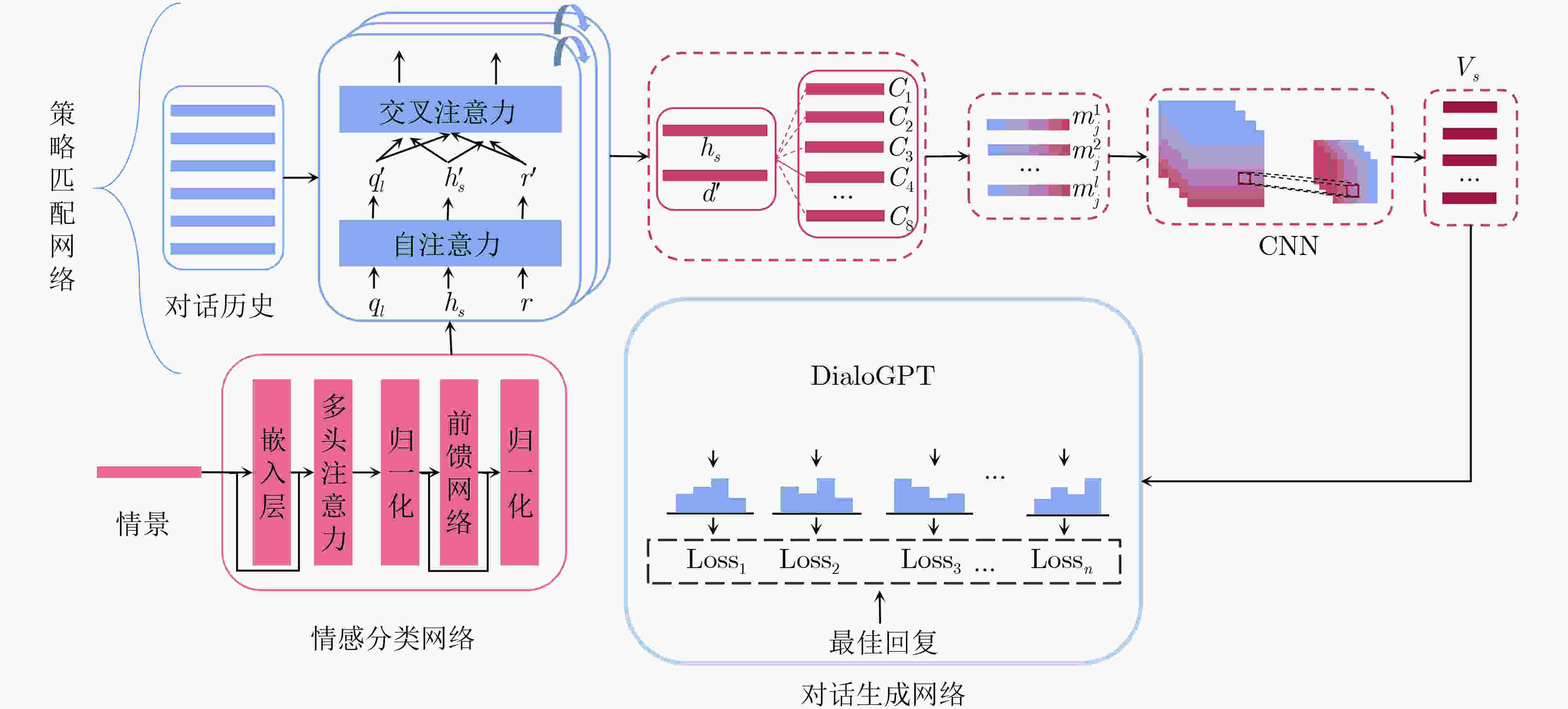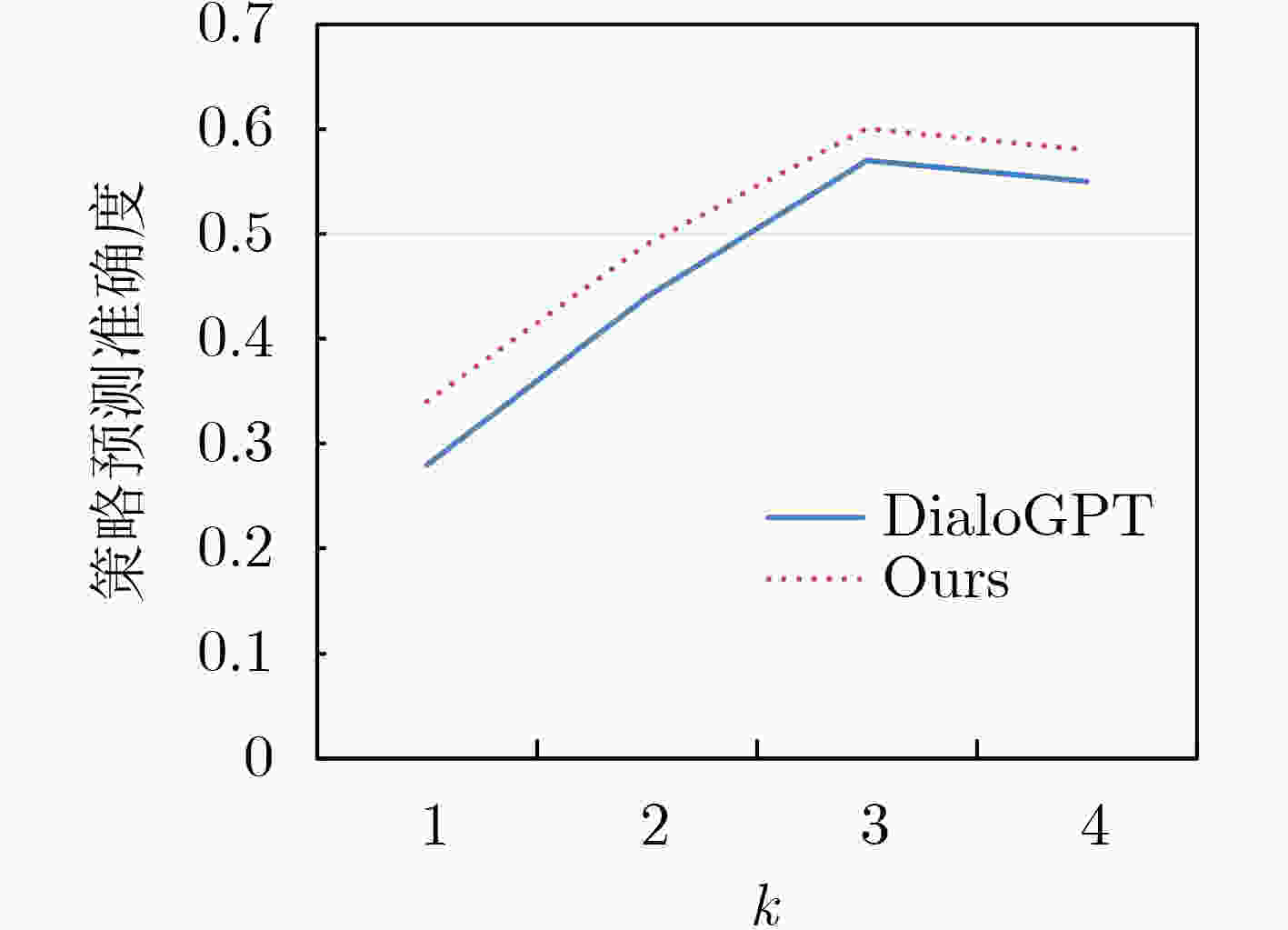Empathetic Dialogue Generation via Sentiment and Support Strategy
-
摘要: 共情对话旨在为情感焦虑的对话系统聊天用户提供心理健康支持,因此,赋予对话系统共情能力是一个值得关注的问题。现有方法往往只能识别用户的情感状态,并不能根据聊天用户不同的情感状态生成有效的、具有同理心的回复,更不能缓解用户的不良情感。因此,在构建情感支持对话系统的研究中,如何动态地捕捉用户的细粒度情感特征并根据情感特征提供相应的心理支持,需要进一步地探索。该文提出一个情感和策略信息融合的共情对话生成方法,该方法首先使用情感分类网络动态感知用户的情感状态;然后利用支持策略准确地建模策略匹配网络,并根据对话上下文引入对话生成网络进行回复生成;最后,通过比较所提方法和当前较为先进的方法在相应数据集上的实验结果,验证所提方法的有效性以及情感支持的重要性。Abstract: Empathic dialogue aims to provide mental health support for anxious users, thus chatbots with empathic capabilities is a noteworthy issue. The existing methods can only identify users’ sentiment states, but can not effectively generate empathetic responses according to users’ different sentiment states and let alone effectively relieve users’ bad emotions. Therefore, in the research of building sentiment support chatbots, how to dynamically capture users’ fine-grained sentiment features and provide corresponding psychological support according to sentiment features needs to be further explored. This paper proposes an empathic dialogue generation method based on the fusion of emotion and strategy. Firstly, the sentiment classification network is used to dynamically perceive the user’s sentiment state. Then the support strategy is used to accurately model the strategy matching network which is introduced according to the context of the conversation to generate the conversation. Finally, by comparing the experimental results of the proposed method and the current advanced methods on the corresponding datasets, the effectiveness of the proposed method and the importance of sentiment support are verified.
-
Key words:
- Empathic dialogue /
- Sentiment support /
- Dialogue generation /
- Support strategy
-
表 1 情感分类和情感支持策略
情感分类 情感支持策略 焦虑 (1)提问:指通过疑问的方式询问用户的感受或是遇到的困难。
(2)重述或转述:对用户的状态进行简单的重述,可以帮助他们更清楚地看到自己的情况。
(3)回复感受:清晰地表达和描述用户的感受。
(4)自我披露:与用户分享相似的经历来表达同理心。
(5)确认和保证:肯定用户的优点和能力,并提供安慰和鼓励。
(6)提供建议:提供关于如何改变的建议告诉他们该怎么做。
(7)信息:为用户提供有用的信息,例如数据、意见、资源等。
(8)其他:使用其他类别的支持策略对用户提供帮助。内疚 抑郁 嫉妒 厌恶 痛苦 恐惧 愤怒 羞耻 悲伤 紧张 表 2 不同模型在ESConv数据集中的自动评价性能
ACC PPL D-1 D-2 B-2 B-4 R-L Transformer – 89.61 1.29 6.91 6.53 1.37 15.17 MT Transformer – 89.52 1.28 7.12 6.58 1.47 14.75 MoEL 21.72 133.1 2.33 15.26 5.93 1.22 14.65 MIME 20.26 47.51 2.11 10.94 5.23 1.17 14.74 DialoGPT 28.57 20.4 4.12 17.72 5.78 1.74 16.39 DCKS 30.74 21.83 4.26 18.20 6.58 2.03 15.77 ours 30.4 19.82 4.30 18.23 6.45 2.04 16.28 表 3 不同模型在ESConv数据集中的人工评价性能
模型 流畅性 相关性 同理心 Transformer 0.62 0.31 0.29 MT Transformer 0.78 0.34 0.82 MoEL 0.36 0.80 0.33 MIME 1.13 0.27 0.35 DialoGPT 1.84 0.62 1.04 DCKS 1.80 0.67 1.14 ours 1.79 0.71 1.15 表 4 消融实验,分别去掉情感分类网络和策略匹配网络
Model D-1 B-2 R-L ours 4.30 6.45 16.28 W/o 分类 3.75 6.28 16.10 W/o 策略 4.10 6.19 16.19 表 5 ESFM和DialoGPT产生响应的对比
情景: I’m fearful of where I'll be living in the future.(我害怕我将来会住在哪里) 用户: I'm looking for someone new to talk to. I don't really feel like I can express my actual feelings in my current living arrangement. (我在一个新的倾诉对象。在我目前的生活安排中,我真的觉得自己无法表达自己的真实感受) 参考: I understand. I have had to stay by myself for most of the year due to the pandemic.That has been hard. (我理解。由于疫情,我不得不一个人待了一年的大部分时间。这很难) [自我披露] DialogGPT: Have a great night and tare care of yourself.(度过一个美好的夜晚好好照顾自己) [回复感受] ESFM: I know there are tough times and we all need to be heard.(我知道现在很艰难,我们都需要被倾听) [自我披露] 表 6 ESFM模型和ChatGPT人工评价性能
模型 情感特性 相关性 同理心 ESFM 积极 0.91 0.34 消极 0.86 0.90 中性 0.82 0.80 ChatGPT 积极 0.95 0.36 消极 0.85 0.85 中性 0.85 0.81 -
[1] 黄宏程, 苏美丹, 寇兰, 等. 基于主从博弈的多方人机交互对话心理模型[J]. 电子与信息学报, 2023, 45(5): 1758–1765. doi: 10.11999/JEIT220441.HUANG Hongcheng, SU Meidan, KOU Lan, et al. Multi-party human-computer interaction dialogue psychology model based on stackelberg game[J]. Journal of Electronics & Information Technology, 2023, 45(5): 1758–1765. doi: 10.11999/JEIT220441. [2] GHOSH S, CHOLLET M, LAKSANA E, et al. Affect-LM: A neural language model for customizable affective text generation[C]. Proceedings of the 55th Annual Meeting of the Association for Computational Linguistics, Vancouver, Canada, 2017: 634–642. doi: 10.18653/v1/P17-1059. [3] ZHOU Hao, HUANG Minlie, ZHANG Tianyang, et al. Emotional chatting machine: Emotional conversation generation with internal and external memory[C]. Proceedings of the 32nd AAAI Conference on Artificial Intelligence, New Orleans, USA, 2018: 730–739. doi: 10.1609/AAAI.V32I1.11325. [4] WEI Wei, LIU Jiayi, MAO Xianling, et al. Emotion-aware chat machine: Automatic emotional response generation for human-like emotional interaction[C]. Proceedings of the 28th ACM International Conference on Information and Knowledge Management. Beijing, China, 2019: 1401–1410. doi: 10.1145/3357384.3357937. [5] LIU Siyang, ZHENG Chujie, DEMASI O, et al. Towards emotional support dialog systems[C]. Proceedings of the 59th Annual Meeting of the Association for Computational Linguistics and the 11th International Joint Conference on Natural Language Processing, 2021: 3469–3483. doi: 10.18653/V1/2021.ACL-LONG.269. [6] 车万翔, 窦志成, 冯岩松, 等. 大模型时代的自然语言处理: 挑战、机遇与发展[J]. 中国科学: 信息科学, 2023, 53(9): 1645–1687. doi: 10.1360/SSI-2023-0113.CHE Wanxiang, DOU Zhicheng, FENG Yansong, et al. Towards a comprehensive understanding of the impact of large language models on natural language processing: Challenges, opportunities and future directions[J]. SCIENTIA SINICA Informationis, 2023, 53(9): 1645–1687. doi: 10.1360/SSI-2023-0113. [7] RASHKIN H, SMITH E M, LI M, et al. Towards empathetic open-domain conversation models: A new benchmark and dataset[C]. Proceedings of the 57th Annual Meeting of the Association for Computational Linguistics, Florence, Italy, 2019: 5370–5381. doi: 10.18653/V1/P19-1534. [8] LIN Zhaojiang, MADOTTO A, SHIN J, et al. MoEL: Mixture of empathetic listeners[C]. Proceedings of the 2019 Conference on Empirical Methods in Natural Language Processing and the 9th International Joint Conference on Natural Language Processing, Hong Kong, China, 2019: 121–132. doi: 10.18653/V1/D19-1012. [9] MAJUMDER N, HONG Pengfei, PENG Shanshan, et al. MIME: MIMicking emotions for empathetic response generation[C]. Proceedings of 2020 Conference on Empirical Methods in Natural Language Processing, 2020: 8968–8979. doi: 10.18653/V1/2020.EMNLP-MAIN.721. [10] HESS U and FISCHER A. Emotional mimicry: Why and when we mimic emotions[J]. Social and Personality Psychology Compass, 2014, 8(2): 45–57. doi: 10.1111/spc3.12083. [11] RADFORD A, WU J, CHILD R, et al. Language models are unsupervised multitask learners[J]. OpenAI Blog, 2019, 1(8): 9. [12] ZANDIE R and MAHOOR M H. Emptransfo: A multi-head transformer architecture for creating empathetic dialog systems[C]. Proceedings of the Thirty-Third International Florida Artificial Intelligence Research Society Conference, North Miami Beach, USA, 2020: 276–281. [13] RADFORD A, NARASIMHAN K, SALIMANS T, et al. Improving language understanding by generative pre-training[J]. 2018. [14] YU Dian and YU Zhou. MIDAS: A dialog act annotation scheme for open domain HumanMachine spoken conversations[C]. Proceedings of the 16th Conference of the European Chapter of the Association for Computational Linguistics, 2021: 1103–1120. doi: 10.18653/V1/2021.EACL-MAIN.94. [15] QIAN Hongjin, DOU Zhicheng, ZHU Yutao, et al. Learning implicit user profile for personalized retrieval-based chatbot[C]. Proceedings of the 30th ACM International Conference on Information & Knowledge Management, Queensland, Australia, 2021: 1467–1477. doi: 10.1145/3459637.3482269. [16] ZHANG Yizhe, SUN Siqi, GALLEY M, et al. DIALOGPT: Large-Scale generative pre-training for conversational response generation[C]. Proceedings of the 58th Annual Meeting of the Association for Computational Linguistics: System Demonstrations, 2020: 270–278. doi: 10.18653/V1/2020.ACL-DEMOS.30. [17] ZHANG Saizheng, DINAN E, URBANEK J A, et al. Personalizing dialogue agents: I have a dog, do you have pets too?[C]. Proceedings of the 56th Annual Meeting of the Association for Computational Linguistics, Melbourne, Australia, 2018: 2204–2213. doi: 10.18653/V1/P18-1205. [18] LI Jiwei, GALLEY M, BROCKETT C, et al. A diversity-promoting objective function for neural conversation models[C]. Proceedings of Conference of the North American Chapter of the Association for Computational Linguistics: Human Language Technologies, San Diego, USA, 2016: 110–119. doi: 10.18653/V1/N16-1014. [19] PAPINENI K, ROUKOS S, WARD T, et al. BLEU: A method for automatic evaluation of machine translation[C]. Proceedings of the 40th Annual Meeting on Association for Computational Linguistics, Philadelphia, USA, 2022: 311–318. doi: 10.3115/1073083.1073135. [20] LIN C Y. ROUGE: A package for automatic evaluation of summaries[C]. Proceedings of Text Summarization Branches Out, Barcelona, Spain, 2004: 74–81. [21] VASWANI A, SHAZEER N, PARMAR N, et al. Attention is all you need[C]. Proceedings of the 31st International Conference on Neural Information Processing Systems, Long Beach, USA, 2017: 6000–6010. [22] CAI Hua, SHEN Xuli, XU Qing, et al. Improving empathetic dialogue generation by dynamically infusing commonsense knowledge[C]. Proceedings of Findings of the Association for Computational Linguistics, Toronto, Canada, 2023: 7858–7873. doi: 10.18653/V1/2023.FINDINGS-ACL.498. -






 下载:
下载:



 下载:
下载:
